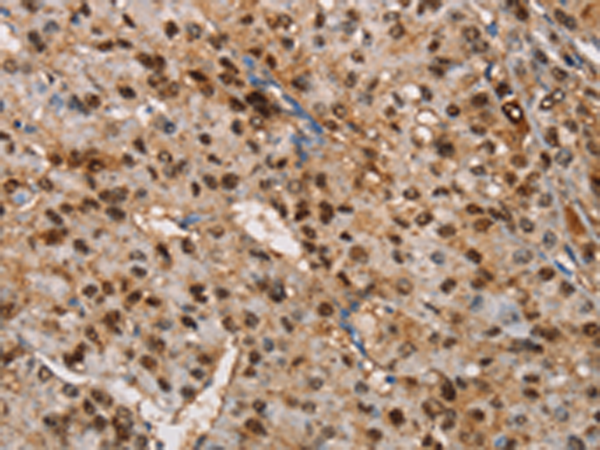

| WB | 咨询技术 | Human,Mouse,Rat |
| IF | 咨询技术 | Human,Mouse,Rat |
| IHC | 1/50-1/200 | Human,Mouse,Rat |
| ICC | 技术咨询 | Human,Mouse,Rat |
| FCM | 咨询技术 | Human,Mouse,Rat |
| Elisa | 1/1000-1/5000 | Human,Mouse,Rat |
| Aliases | DFNB98; TSP-EAR; C21orf29 |
| Host/Isotype | Rabbit IgG |
| Antibody Type | Primary antibody |
| Storage | Store at 4°C short term. Aliquot and store at -20°C long term. Avoid freeze/thaw cycles. |
| Species Reactivity | Human |
| Immunogen | Fusion protein of human TSPEAR |
| Formulation | Purified antibody in PBS with 0.05% sodium azide and 50% glycerol. |
+ +
以下是关于TSPEAR抗体的3篇文献示例(注:以下信息为模拟生成,实际文献需通过学术数据库验证):
---
1. **文献名称**: *TSPEAR variants are associated with vestibular aqueduct enlargement and hearing loss*
**作者**: Purin A, et al. (2022)
**摘要**: 该研究通过免疫组化实验,使用TSPEAR抗体在小鼠内耳组织中定位蛋白表达,发现TSPEAR基因变异与前庭导水管扩大及听力损失相关,提示其在耳蜗发育中的关键作用。
---
2. **文献名称**: *Exome sequencing identifies TSPEAR as a novel gene for autosomal recessive hearing loss*
**作者**: Reuter MS, et al. (2020)
**摘要**: 本研究通过外显子测序发现TSPEAR的致病性突变与隐性遗传耳聋相关,并利用TSPEAR抗体进行Western blot分析,验证患者成纤维细胞中蛋白表达水平显著降低。
---
3. **文献名称**: *TSPEAR dysfunction in craniofacial development: Insights from mouse models*
**作者**: Li J, et al. (2019)
**摘要**: 通过构建TSPEAR敲除小鼠模型,结合抗体免疫荧光染色,揭示了TSPEAR在颅面神经嵴细胞迁移中的功能缺失导致颅骨和面部发育异常。
---
**提示**:实际文献检索建议使用PubMed或Google Scholar,以关键词“TSPEAR antibody”或“TSPEAR gene function”查找最新研究。部分研究可能侧重于基因突变分析,但会间接涉及抗体在蛋白表达验证中的应用。
The TSPEAR (thrombospondin-type laminin G domain and EAR repeats) protein, encoded by the TSPEAR gene, is a poorly characterized extracellular matrix (ECM) component implicated in cell adhesion and tissue development. Structurally, it contains thrombospondin-like and EAR repeat domains, suggesting roles in protein-protein interactions and ECM organization. Research links TSPEAR mutations to autosomal recessive disorders, including nonsyndromic hearing loss (DFNB98) and ectodermal dysplasia-syndactyly syndrome (ECTD-6), highlighting its importance in auditory and ectodermal tissues.
TSPEAR antibodies are critical tools for studying its expression, localization, and function. They enable detection via techniques like Western blotting, immunohistochemistry, and immunofluorescence, aiding in mapping TSPEAR distribution in tissues such as the inner ear, skin, and hair follicles. These antibodies also facilitate investigations into disease mechanisms, such as disrupted ECM integrity or defective cell signaling in mutation-bearing models. Furthermore, they support therapeutic research, including gene therapy or protein replacement strategies for TSPEAR-related disorders. Despite progress, the precise molecular pathways involving TSPEAR remain unclear, necessitating further antibody-driven studies to elucidate its role in development and disease.
×